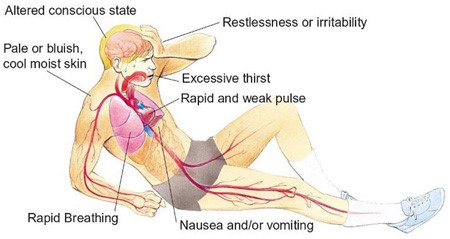Which of the following ECG rhythm interval measures is considered abnormal?
QTc interval 0.33 to 0.47 seconds
QT interval that varies with HR
QRS interval <0.12 seconds
PR interval 0.12 to 0.24 seconds
The Correct Answer is A
The QTc (corrected QT) interval is a measure of the time it takes for the ventricles to depolarize and repolarize during a cardiac cycle. It is corrected for heart rate (HR) to account for variations in the cardiac cycle length.
The normal range for the QTc interval varies depending on the calculation method used but generally falls within 0.36 to 0.44 seconds. In the given options, the range of 0.33 to 0.47 seconds for the QTc interval is wider than the normal range, suggesting a prolonged QTc interval, which can be indicative of a potential risk for arrhythmias, including ventricular tachycardia and torsades de pointes.
B. QT interval that varies with HR in (option B) is normal because The QT interval alone can vary with heart rate, and this is considered a normal physiological adaptation.
C. QRS interval <0.12 seconds in (option C) is normal because The QRS interval represents the time it takes for ventricular depolarization and is normally less than 0.12 seconds.
D. PR interval 0.12 to 0.24 seconds in (option D) is normal because The PR interval represents the time it takes for atrial depolarization and conduction through the AV node. The normal range is typically 0.12 to 0.20 seconds.

Nursing Test Bank
Naxlex Comprehensive Predictor Exams
Related Questions
Correct Answer is D
Explanation
In septic shock, prompt administration of antibiotics is crucial in order to target the underlying infection and prevent further progression of the septic process. Antibiotics help to eradicate the causative organisms and reduce the bacterial load, which can help improve patient outcomes.
While all the options mentioned are important interventions in the management of septic shock, initiating antibiotic therapy is considered a priority in order to address the underlying infection and prevent sepsis-related complications.
A. Giving a 2000 mL normal saline bolus in (option A) is incorrect because: Fluid resuscitation is important in septic shock to restore intravascular volume, but antibiotic therapy takes precedence as it directly targets the underlying infection.
B. Starting an insulin drip to maintain blood glucose at 110 to 150 mg/dL in (option B) is incorrect because Glycemic control is important in septic shock, but it is not the first priority compared to addressing the infection.
C. Giving acetaminophen (Tylenol) 650 mg rectally in (option C) is incorrect because Antipyretic medications can help reduce fever, but they do not address the underlying infection or stabilize the patient's condition.
E. Starting norepinephrine (Levophed) to keep systolic blood pressure >90 mm Hg in (option E) is incorrect because: Vasopressor support may be necessary in septic shock to maintain adequate blood pressure, but initiating antibiotics takes priority in order to address the underlying infection.
Therefore, in a patient with septic shock presenting with the given signs and symptoms, the nurse should first implement the intervention of giving the prescribed antibiotics to target the underlying infection.
Correct Answer is C
Explanation
Hypovolemic shock is a life-threatening condition resulting from severe blood or fluid loss. The patient in this scenario exhibits signs of hypovolemic shock, such as low blood pressure, tachycardia, cool and clammy skin, and decreased urine output.
When assessing the prescription options, the nurse should consider the appropriateness of each intervention for hypovolemic shock. Plasmanate is a type of plasma protein fraction that is used for volume expansion in certain situations. However, in hypovolemic shock, the primary intervention is to restore intravascular volume promptly. Plasmanate alone may not be sufficient for rapid-volume resuscitation.
In hypovolemic shock, the initial management typically involves the administration of crystalloid solutions, such as Lactated Ringers or Normal Saline, to restore intravascular volume. Therefore, the prescription of Plasmanate as the primary intervention raises concerns and should be questioned by the nurse.
A. Dopamine (Intropin) 12 mcg/min in (option A) is incorrect because: Dopamine is a vasopressor medication used to increase blood pressure and cardiac output. It is a suitable option for hypovolemic shock to support blood pressure and tissue perfusion.
B. Dobutamine (Dobutrex) 5 mcg/kg/min in (option B) is incorrect because: Dobutamine is an inotropic medication that helps improve cardiac contractility and cardiac output. It can be beneficial in cases of hypovolemic shock with signs of poor cardiac function.
D. Bumetanide (Bumex) 1 mg IV in (option D) is incorrect because: Bumetanide is a loop diuretic used to promote diuresis. However, in the context of hypovolemic shock, diuretics are generally not the first-line treatment as they can further reduce intravascular volume and worsen the patient's condition.
It is essential for the nurse to consult with the healthcare provider regarding the prescription order of Plasmanate and consider alternative interventions for rapid volume resuscitation in hypovolemic shock.

Whether you are a student looking to ace your exams or a practicing nurse seeking to enhance your expertise , our nursing education contents will empower you with the confidence and competence to make a difference in the lives of patients and become a respected leader in the healthcare field.
Visit Naxlex, invest in your future and unlock endless possibilities with our unparalleled nursing education contents today
Report Wrong Answer on the Current Question
Do you disagree with the answer? If yes, what is your expected answer? Explain.
Kindly be descriptive with the issue you are facing.
